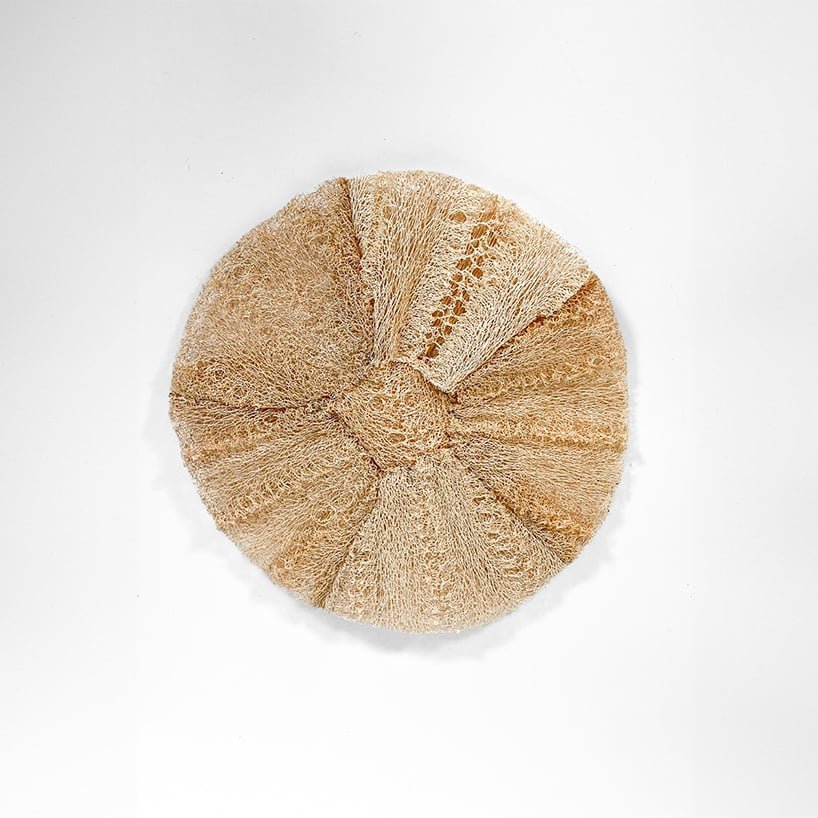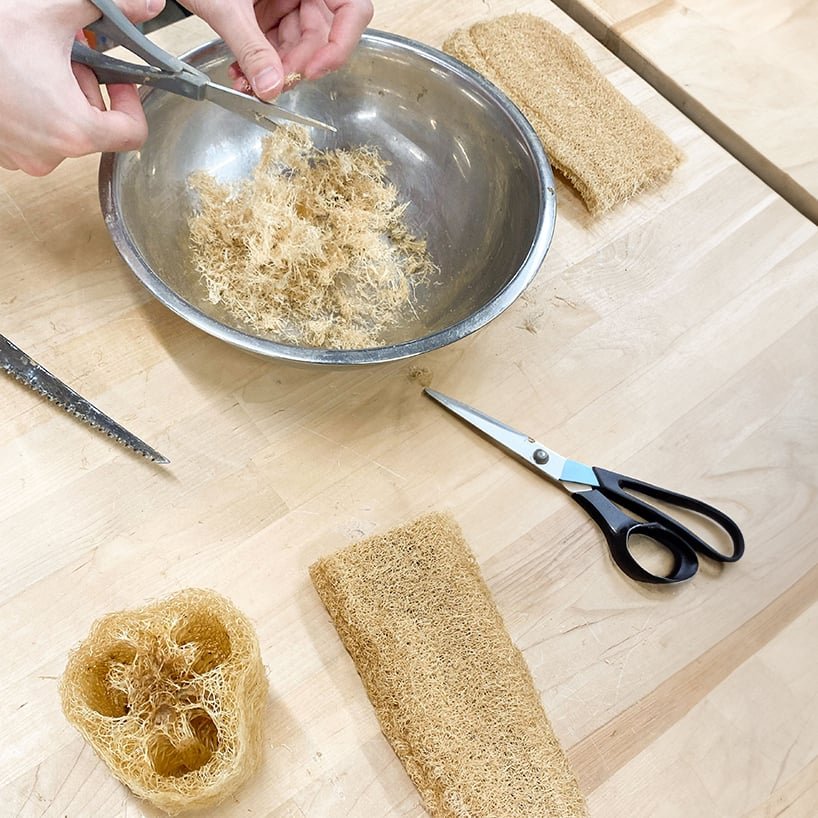The Luffa Stoolita project uses luffa sponges and coffee grounds to explore sustainable furniture design. Spearheaded by Columbia University GSAPP students, it demonstrates the potential of plant-based by-products for structural integrity and eco-friendly design. The stool combines luffa’s tensile strength with coffee-aggregate and clay-rich soil, highlighting responsible consumption and environmental consciousness.
From Chow to Chair
- Luffa Stoolita
Mar 3, 2024
Materials
Connetion : +54126
Shares : 42124
Chow to Wow: Transforming Luffa Sponges and Spent Coffee Grounds into Sustainable Furniture
In response to the growing food waste issue exacerbated by increased online food delivery services during the COVID-19 lockdowns, the Luffa Stoolita explores the potential of plant-based by-products as alternative materials for design and construction. This design serves as a symbol of responsible consumption and low-impact solutions to address food waste.
Columbia University GSAPP master’s students Justin Wan, Paul Edward Liu, and Tim Ting-Hao Chen spearheaded the project, aiming to harness the physical attributes of the luffa fruit to enhance the structural integrity of earth-based designs. By repurposing plant-based by-products and their residual waste, the design showcases the potential to extend the life cycle of food beyond its fleeting period of consumption. Emphasizing environmental consciousness, all materials used in the project are locally sourced.
Under the guidance of Columbia University GSAPP Professor Lola Ben Alon, the team focused their research on the combined application of luffa sponges, spent coffee grounds, and clay-rich soil as aggregate and binding agents to craft the stool design. Experimentation involved blending coffee aggregates, shredded luffa, and earth as a binding agent to create composite materials capable of withstanding stress without crumbling. Given the project's core concept of using food waste for design without generating additional waste, all parts of the luffa fruit are utilized in each component of the furniture piece.
Leveraging the luffa's inherent tensile properties, the team engineered the legs from halved luffa segments. Acting as formwork, the luffa segments are filled with the identified earth-coffee blend, each time in thin layers and tamped to ensure proper compaction. The seat base is made from a similar earth blend, mixed with shredded luffa as a reinforcing material to control shrinkage and provide flexibility. The cushion, crafted from the outer surface of the luffa fruit, is turned inside-out to reveal a smoother surface, offering enhanced comfort. Additionally, the design exposes intricate patterns where the seeds were once nestled. The cushion is carefully affixed to the seat base while the latter is still damp, followed by thorough drying to ensure optimal adhesion. The material combination results in a sturdy and compact design that fuses the lightweight and rigid structure of the luffa with the strength and heftiness of earthen materials.
This eco-conscious creation challenges the norms of furniture design, demonstrating the feasibility of using luffa fruit for load-bearing purposes at the human scale. Standing 240mm tall with a 315mm diameter, the Luffa Stoolita embodies the ethos of responsible consumption and sustainable design, offering a tangible solution to combat food waste and promote environmental stewardship.
從食物到家具:將絲瓜海綿和咖啡渣變成永續家具
由於COVID-19封鎖期間外送服務的增加,加劇了食物浪費問題,Luffa Stoolita探索了植物副產品作為設計和施工替代材料的潛力。設計象徵負責任的消費和低影響設計,以解決食物浪費問題。
哥倫比亞大學GSAPP碩士生Justin Wan、Paul Edward Liu和Tim Ting-Hao Chen領導了這個項目,旨在利用絲瓜的物理特性來增強基於泥土的設計的結構完整性。透過再利用植物副產品及其殘餘廢料,該設計展示了延長食物生命週期的潛力。所有使用的材料均為本地採購,強調了環境意識。
在哥倫比亞大學GSAPP教授Lola Ben Alon的指導下,團隊研究了絲瓜海綿、咖啡渣和富含黏土的土壤結合應用,作為骨材和黏合劑來製作凳子設計。實驗將咖啡骨材、碎絲瓜和土壤混合作為黏合劑,創造了能夠承受壓力而不崩裂的複合材料。由於專案核心理念是使用食物廢料進行設計而不產生額外廢料,因此每個家具零件都使用了絲瓜果實的所有部分。
利用絲瓜的固有拉伸特性,團隊將腿部設計成由半絲瓜段製成。這些絲瓜段作為模板,填充已確定的泥土-咖啡混合物,每次以薄層填充並夯實以確保適當壓實。座位基座由類似的泥土混合物製成,並混入碎絲瓜作為增強材料,以控制收縮和提供靈活性。靠墊由絲瓜果實的外表面製成,翻轉內外以露出更光滑的表面,提供更好的舒適性。此外,設計也展示了曾經藏有種子的複雜圖案。靠墊在基座仍然潮濕時小心固定,隨後充分乾燥以確保最佳黏附。材料組合形成了堅固而緊湊的設計,將絲瓜的輕盈剛性結構與泥土材料的強度和沈重性融合在一起。
這種環保創作挑戰了家具設計的常規,展示了在人體尺度上使用絲瓜承重的可行性。 Luffa Stoolita高240毫米,直徑315毫米,體現了負責任消費和永續設計的精神,提供了應對食物浪費和促進環境管理的實際解決方案。
Justin Wan & Team
Justin Wan is a multidisciplinary designer passionate about eco-conscious designs prioritising human health and the natural environment. He is intrigued by evolving designs and draws inspiration from botanical sciences, exploring the potential of plants as alternative construction materials to enhance natural ecosystems.
Fascinated by the intricate physical structures of the luffa fruit, Justin and his design team have crafted a furniture piece using luffa sponges, coffee grounds, and soil. This innovative creation aims to encourage responsible consumption and pioneer sustainable furniture solutions with organic materials.
Justin Wan是一位多學科設計師,他熱衷於生態意識設計,優先考慮人類健康和自然環境。他對不斷發展的設計感興趣,從植物科學中汲取靈感,探索植物作為替代建築材料的潛力,並利用其特性來增強自然生態系統。
Justin和他的設計團隊對絲瓜果實的複雜物理結構著迷,利用絲瓜海綿、咖啡渣和土壤製作了一件家具。這項創新作品旨在鼓勵負責任的消費,並以有機材料開創永續家具解決方案。
Instagram handle: @just1nwan
email: jcw2232@columbia.edu
Website: https://www.linkedin.com/in/justin-a-wan-leed-ap-00000001/
M.S. Advanced Architectural Design, Columbia University Graduate School of Architecture, Planning, and Preservation

























